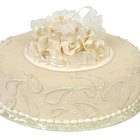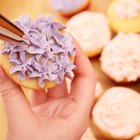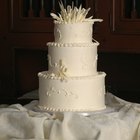
One of the first crucial techniques aspiring cake decorators must learn is applying a crumb coat. This is just a thin layer of ordinary icing, spread over the cake layers to trap any loose crumbs and prevent them from spoiling the appearance of your finished cake. Basic beginners' icing is usually rather stiff and hard to spread thinly, so it's tempting to use a softer substance such as whipped cream for the crumb coat. This doesn't work well, however, and there are better alternatives.
What the Crumb Coat Does
To understand why whipped cream makes a poor crumb coat, you need to understand how the crumb coat works. Its primary role is to act as a sort of adhesive, sticking loose crumbs to the cake's surface so they'll stay put when you finish the cake. The crumb coat also seals the cake, preventing moisture loss as it awaits its final coat of icing. Finally, the crumb coat must also provide a stable, smooth base for the final icing. That helps ensure that the cake will have an even, professional-looking finish.
How Cream Falls Short
Whipped cream might look like light, fluffy icing, but the appearance is misleading. It's relatively unstable, quickly deflating and returning to its original condition as heavy whipping cream. This means it's ineffective in immobilizing crumbs, since it won't bind them to the cake. Instead it softens them enough to create smears in the icing rather than crumbs, a different effect but no more desirable. Cream also provides an unsuitable base for spreading further icing, since your finishing coat will slide on the wet surface rather than adhering. Cream doesn't seal the cake's surface, either, but it supplies enough moisture of its own to compensate for any evaporation.
A Better Option
If your icing is too stiff to spread thinly as a crumb coat, give some thought to tweaking it rather than finding a substitute. The simplest alteration is simply to put the icing back in your mixing bowl and beat it longer. This incorporates extra air, which makes the icing more spreadable, and the friction of the beater passing through the icing warms the butter gently softens it. You can also add a tablespoon or two of milk or cream, which thins the icing. A second benefit of adding milk is that the icing forms a crust as it dries, which makes it a better base for your final coat of icing.
Alternative Crumb Coats
If you can't manage to coax your usual frosting into making a good crumb coat, there are alternatives. The simplest is to keep one or two plastic tubs of commercial icing on hand, just to use for crumb coating. It's always soft and spreadable, but if you use your own icing to finish the cake that's all anyone will notice. If you're covering your cake with rolled buttercream, fondant or marzipan, you have the option of brushing the cake instead with softened apricot jam or currant jelly. Once it dries to a tacky surface, it makes a fine crumb coat and adhesive for these dough-like types of frosting.
Related Articles

How to Make Frosting Hard for a Cake

What Is Dirty Icing in Cake Decorating?

How to Make Whipped Frosting Without ...

How to Keep Cake Moist Overnight ...
Should Cake Flour Be Sifted Before ...

How to Pipe with Whipped Cream

How to Soften a Stiff Buttercream

What Do You Use to Make Fondant Stick?
How to Make Bakery-Style Whipped Icing

Ganache Substitute

Should You Frost a Frozen Cake or Wait ...

How to Decorate Fake Cakes

The Difference Between Butter Cream and ...
How to Make Homemade Frosting With ...

How Long Does it Take for Marzipan to ...

How to Keep My Frosting From Falling ...

Can You Use Heavy Cream When Making ...

How to Make Buttercream Frosting Spread ...

How to Fix a Broken Baked Cake

What Are the Functions of Cream of ...
References
- The Professional Pastry Chef; Bo Friberg
- Wilton: Start With a Crumb Coat for a Smooth Cake Finish
Writer Bio
Fred Decker is a trained chef and prolific freelance writer. In previous careers, he sold insurance and mutual funds, and was a longtime retailer. He was educated at Memorial University of Newfoundland and the Northern Alberta Institute of Technology. His articles have appeared on numerous home and garden sites including GoneOutdoors, TheNest and eHow.
Photo Credits
Thinkstock/Comstock/Getty Images